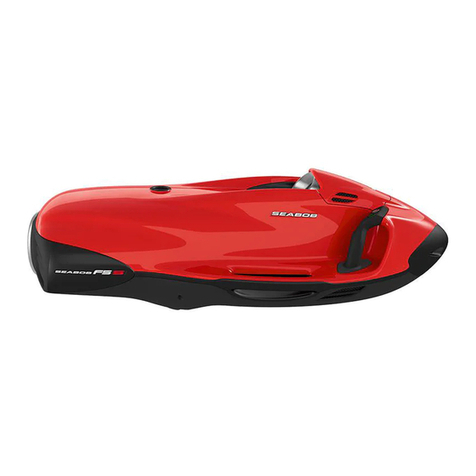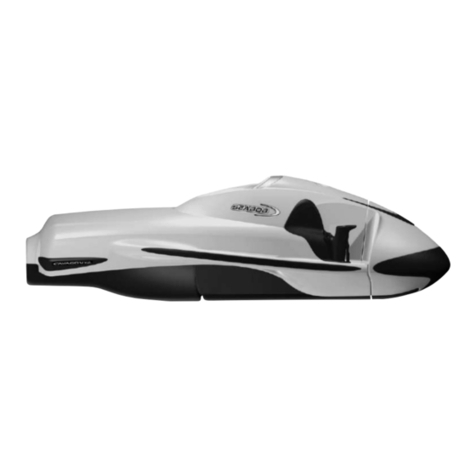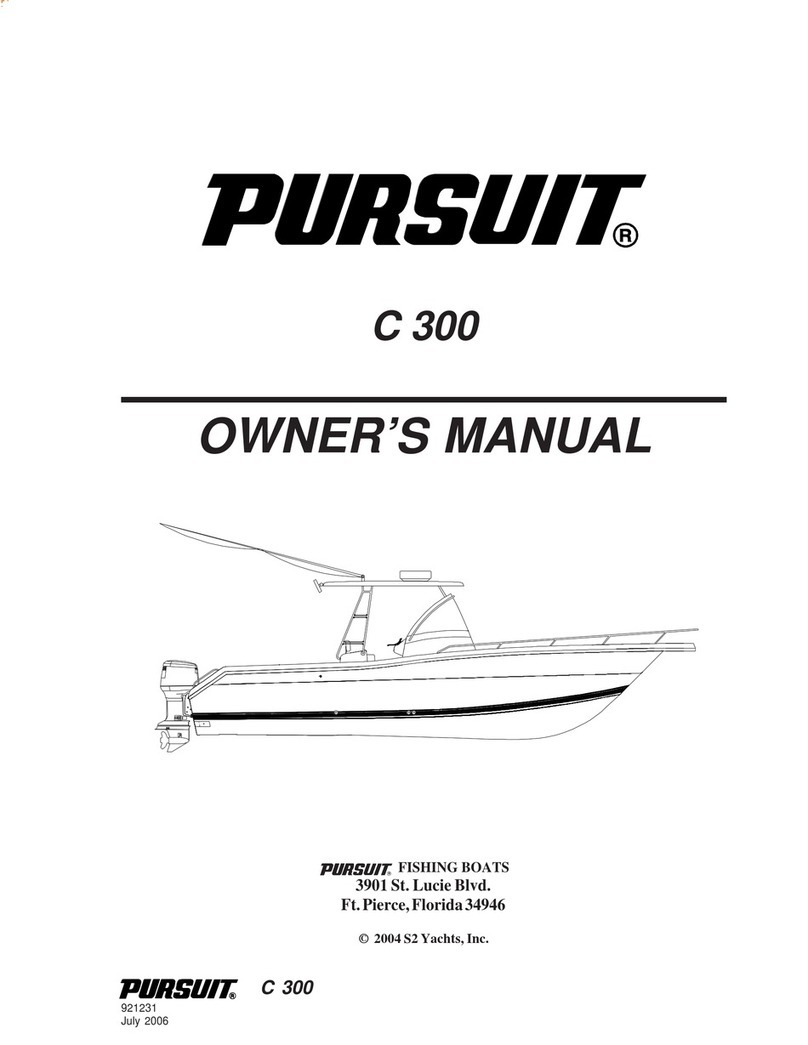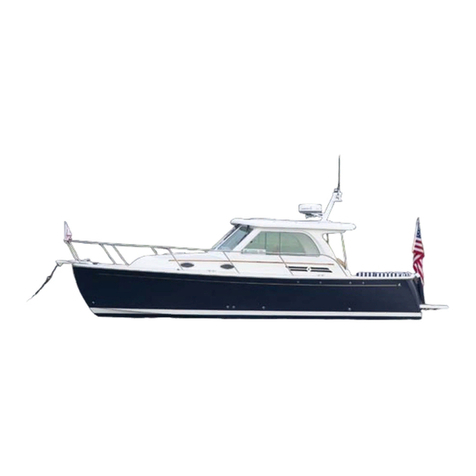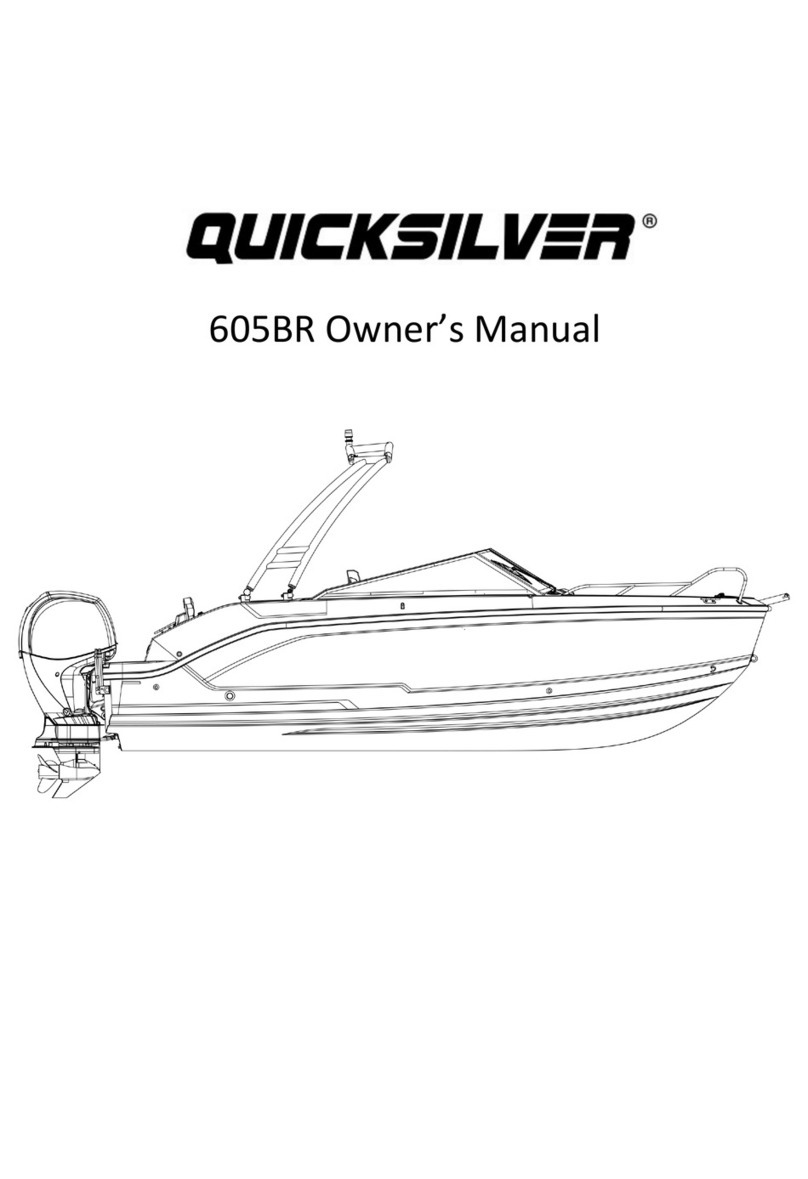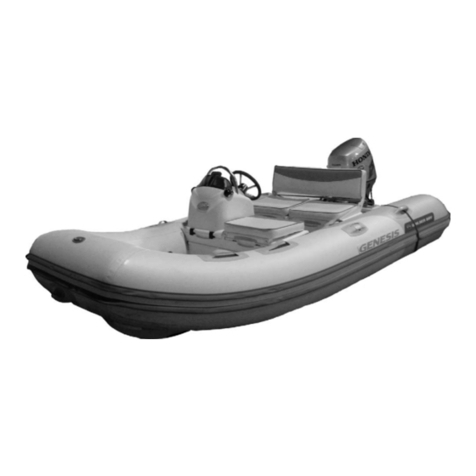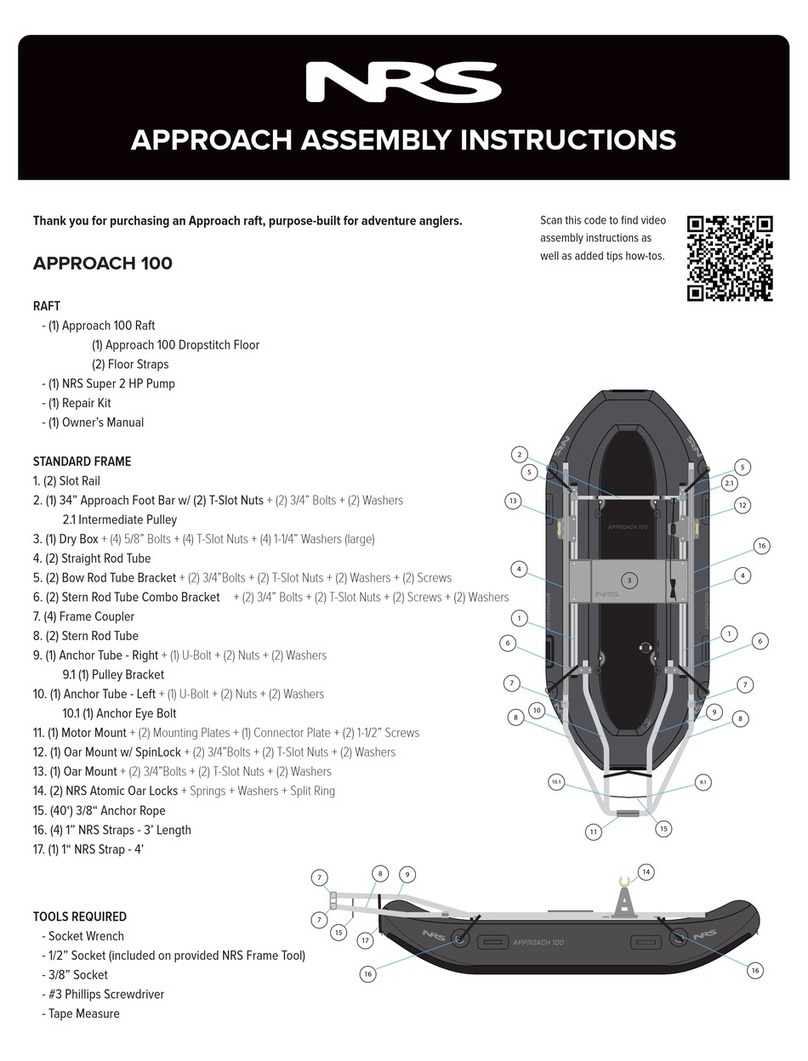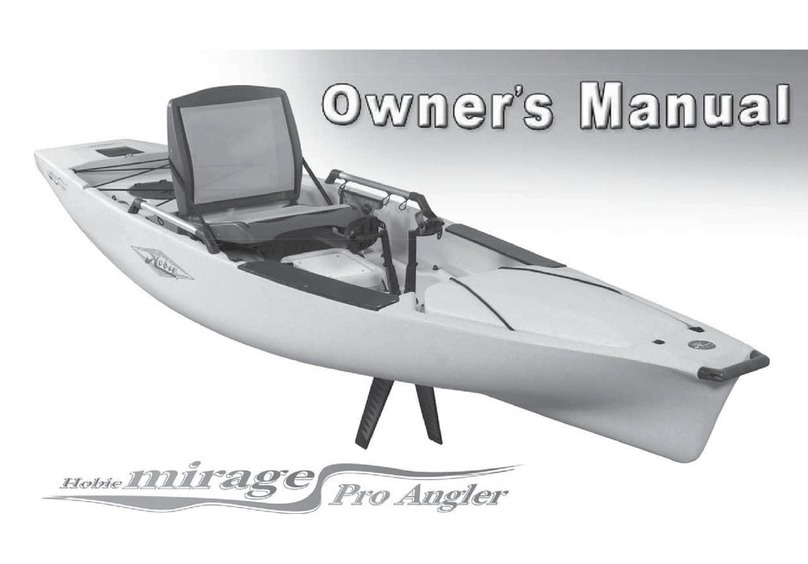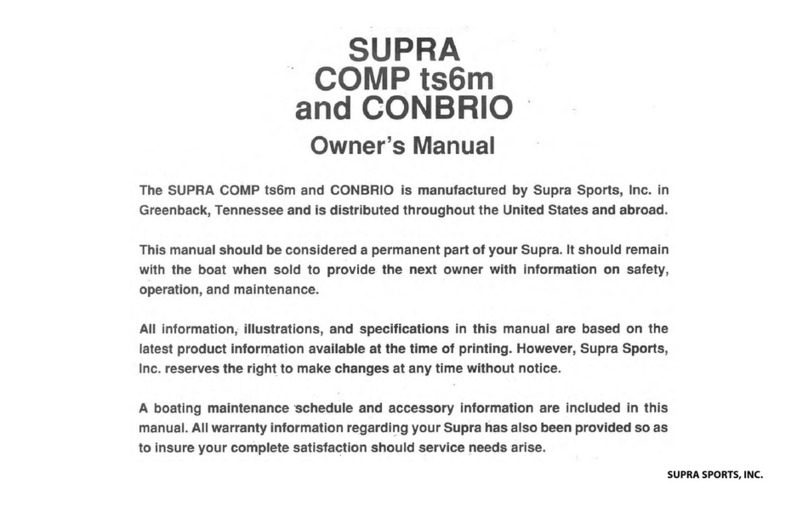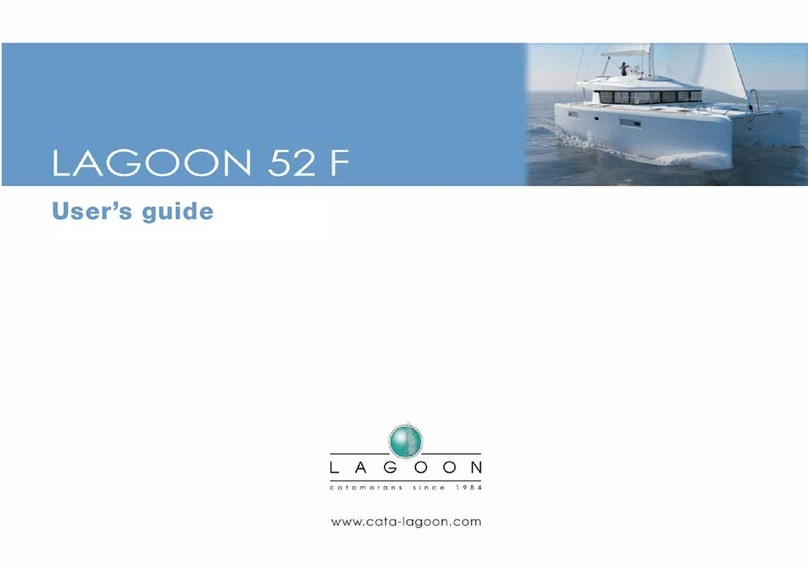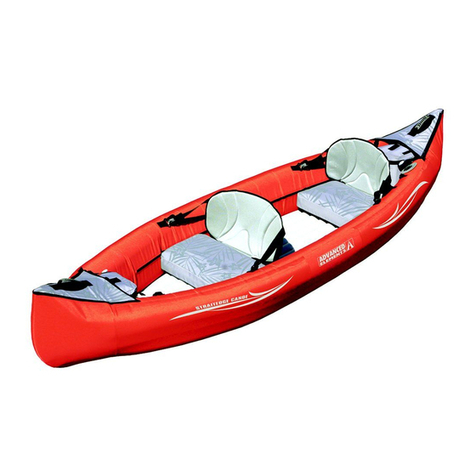SEABOB F5 User manual

English
Operator's Manual
Read this manual carefully and completely before operating the SEABOB


Introduction
Congratulations on the purchase of your new SEABOB! The SEABOB is an innovative water-sports craft that allows
you to move through water in a virtually silent and ecologically friendly way without producing emissions. In develop-
ing the SEABOB, special attention has been given to hydrodynamics and ergonomic handling.The SEABOB impresses
with its exclusive design coupled with high performance and advanced technology.
Like all watercraft, the SEABOB requires that operators take specific precautions when using it. For this reason, we
urge you to read through the Operator's Manual carefully and completely – in particular, the safety information
and the instructions on proper use – before operating the SEABOB.
So get ready to dive into a fascinating new world! We wish you many hours of fun with your SEABOB!
The following symbols are used in this Operator's Manual to bring your attention to important information:
Risk of serious injury and / or death. This symbol indicates that operating the SEABOB involves a
hazardous situation that, if not avoided, could result in death or serious injury.
Risk of minor or moderate injury. This symbol indicates that operating the SEABOB involves a haz-
ardous situation that, if not avoided, could result in minor or moderate injury.
Not heeding this information may result in damage to or destruction of the SEABOB or other property.
Tip: Tips provide you with important operating information or other information that can help you to understand the
operation of the SEABOB better.
If you have any questions regarding the operation of your SEABOB, please contact your dealer or CAYAGO AMERICAS
INC. at the phone number and address found at the end of this Operator's Manual.
CAYAGO AMERICAS INC. constantly works on optimizing its products over the course of product development. As a
result, CAYAGO AMERICAS INC. reserves the right to change or modify the product characteristics specified in this
Operator's Manual at any time without prior notice. Characteristics and functions described and illustrated in this
Operator's Manual may differ from the actual characteristics and functions of the product.
SEABOB is a registered trademark.

| Page 4 | SEABOB Operator's Manual |
Contents
1. Safety information .................................................................................................................................... 6
1.1 Special safety information ................................................................................................................................... 7
1.2 General safety information .................................................................................................................................. 9
1.3 Safety information for diving to a depth of up to 2.5 m / 8 ft ........................................................................... 16
1.4 Safety information for diving to a depth of more than 2.5 m / 8 ft ................................................................... 17
1.5 Safety information concerning the batteries ...................................................................................................... 19
2. Proper use ............................................................................................................................................... 21
2.1 Registration papers / driving licence ................................................................................................................. 22
2.2 Operation area .................................................................................................................................................. 22
3. Included in delivery ................................................................................................................................. 23
4. Description of the device ........................................................................................................................ 24
4.1 SEABOB housing .............................................................................................................................................. 24
4.2 Right Control Grip ............................................................................................................................................. 25
4.3 Left Control Grip ................................................................................................................................................ 25
5. Operation ................................................................................................................................................. 26
5.1 Start-up ............................................................................................................................................................. 26
5.2 Charging the SEABOB ....................................................................................................................................... 26
5.3 Operating the SEABOB ...................................................................................................................................... 30
5.3.1 Controls and display panel .......................................................................................................................... 30
5.3.2 Arrangement of the controls ........................................................................................................................ 31
5.3.3 Using the controls ........................................................................................................................................ 31
5.3.4 Information Display ..................................................................................................................................... 32
5.3.5 Off mode (Air Transport / Storage) – switching on / off ............................................................................... 34
5.3.6 Sleep mode / On mode – switching on / off ................................................................................................. 35
5.3.7 Charge mode ............................................................................................................................................... 36
5.3.8 Charge display ............................................................................................................................................. 37
5.3.9 Displaying serial numbers ............................................................................................................................ 38
5.3.10 Entering PIN (Owner-PIN / User-PIN) ......................................................................................................... 38
5.3.11 Settings (menu) ......................................................................................................................................... 39
5.3.12 Operation ................................................................................................................................................... 41
5.4 Before starting ................................................................................................................................................... 42
5.5 Operation on the water surface ......................................................................................................................... 43
5.5.1 How to navigate your SEABOB .................................................................................................................... 43
5.5.2 SEABOB charge state and emergency reserve ............................................................................................. 45
5.6 Diving to a depth of up to 2.5 m / 8 ft ............................................................................................................... 45
5.6.1 How to dive with your SEABOB ................................................................................................................... 46

| Page 5 | SEABOB Operator's Manual | 2410 37 611 512 9 8 1
5.7 Diving to a depth of more than 2.5 m / 8 ft ....................................................................................................... 46
5.7.1 Setting the maximum diving depth .............................................................................................................. 47
5.7.2 Adjusting the buoyancy of the SEABOB ....................................................................................................... 48
5.8 After use ............................................................................................................................................................ 48
5.9 Switching the SEABOB to the Sleep mode ......................................................................................................... 49
5.10 Storing the SEABOB ....................................................................................................................................... 50
5.11 Air transport / transport of the SEABOB ......................................................................................................... 51
5.12 Switching off the SEABOB for storage or transport ......................................................................................... 53
6. Care ......................................................................................................................................................... 54
6.1 Cleaning the SEABOB ........................................................................................................................................ 54
6.2 Changing the screw cap .................................................................................................................................... 55
7. Troubleshooting ....................................................................................................................................... 56
7.1 SEABOB cannot be switched on ........................................................................................................................ 56
7.2 Motor does not run ........................................................................................................................................... 57
7.3 Warning and error message on the Display ........................................................................................................ 57
7.4 Impeller does not turn (no thrust) ..................................................................................................................... 58
7.5 Trigger does not function properly ..................................................................................................................... 58
7.6 Moisture present in connection port ................................................................................................................. 59
7.7 SEABOB cannot be charged ............................................................................................................................... 59
8. Technical specifications ........................................................................................................................... 60
9. Disposal ................................................................................................................................................... 64
10. Replacement parts ................................................................................................................................. 65
11. Service ................................................................................................................................................... 66
12. Imprint ................................................................................................................................................... 67
In reviewing this Operator's Manual, please note the
following Conversion Chart for converting distances
from Meters to Feet:
Meters Feet
0.3 m
0.5 m
1 m
2 m
1 ft
1.5 ft
3.5 ft
6 ft
Meters Feet
2.5 m
3 m
5 m
40 m
8 ft
10 ft
17 ft
131 ft

1
| Page 6 | SEABOB Operator's Manual |
Please read the following important information!
Failure to do so can result in death, serious injury or property damage.
1. Safety information
The SEABOB is a state-of-the-art device. It conforms to current standards and is safe to operate if used properly. Failure
to use the device as designed and/or failure to follow the safety information, may cause serious injury or death of the
operator, injury or death of others, or cause damage to the SEABOB, and/or other property.
For this reason, we strongly urge you to read the Operator's Manual and the safety information contained in this
Manual carefully before you operate your SEABOB for the first time. The information contained in the Operator's
Manual will help you to operate the SEABOB safely, protect yourself and others from hazards, and prevent damage to
the device and other property.
Keep this Operator's Manual in a safe and easily accessible place for reference whenever needed. Do not discard.
Please also keep the original packaging. It can be used again later to provide optimum protection for the device (for
example, when sending the device in for service).
ATTENTION
AVOID COMPLETE
DISCHARGE OF THE BATTERY!
Charge the SEABOB
• immediately after delivery (within 1 week),
• after each use (within 24 hours) and
• continuously ("trickle-charge")
during longer periods of storage
The charge should be to the minimum charge
state of "Air Transport / Storage"
to avoid an irreparable complete
discharge of the valuable High-Energy
Lithium-Ion battery.

1
| Page 7 | SEABOB Operator's Manual |
1.1 Special Safety Information
Special safety information for the SEABOB
• Important! Observe Operator's Manual!
• Suitable only for strong swimmers aged 16 or older!
• The SEABOB is not intended as a flotation device and is not a life-saving device.
Do not use as a swimming aid!
• Wear a life jacket at all times when using the SEABOB!
• Wear close-fitting clothing (without loose straps or belts)!
• Wear a bathing cap or hair net if hair is shoulder-length or longer!
• Do not reach into SEABOB's openings (jet channel)! Rotating parts!
• Do not use in open water!
• Do not use in strong currents, heavy swells or when there is poor visibility!
• Do not use in areas where there are other swimmers or divers!
• Maintain a distance (minimum 5 m / 17 ft) from other people and objects!
• Do not use at a depth of less than 1 m / 3.5 ft!
• Always observe the battery level and return to the shore in time!
• Do not store in sunlight or in a closed motor vehicle!
Special safety information for the Batteries
• Important! Follow the directions in the Operator's Manual!
• Do not allow to exceed a temperature above 60 °C / 140 °F!
• Do not store in sunlight or in a closed motor vehicle!
• Do not short circuit!
• Do not open!
• Do not puncture!
• Do not strike!
• Do not burn!
• Use only chargers supplied by CAYAGO AMERICAS INC. and use only the
specific charger made for your SEABOB model!
• Charge only in dry locations!
Please pay particular attention to the following critical safety information. Failure to do
so may result in serious injury, death or property damage.

1
| Page 8 | SEABOB Operator's Manual |
• Never transport a fully charged SEABOB by airplane or over long distances!
• Observe instructions on charging, discharging, storage and transport!
• Failure to follow these instructions can lead to the release of flammable gases,
which may cause serious injury or death!
Special safety information for the Charger
• Important! Observe Operator's Manual!
• Do not expose to direct sunlight! Do not open!
• Use only with clean and dry plug and outlet connections!
• Keep Charger dry!
• Never use if cables or plugs are damaged!
• Charge only in dry, cool and well ventilated locations!
• Do not cover the Charger! Ensure that air can circulate around the Charger!
• Heats up during charging process! Allow Charger to cool before handling!
Never expose the SEABOB or Charger to high temperatures (max. 60 °C / 140 °F) including high
temperatures caused by open fire, direct sunlight or storage in a closed motor vehicle or trunk.
If exposed to heat, flammable gases can be discharged causing serious injury or death. In addition,
the Display screen may become irreparably damaged if exposed to heat.
Never transport a fully charged SEABOB by airplane or over long distances. The SEABOB should only be partially
charged during transport (selected the "Air Transport / Storage" option). Only switch off the SEABOB for transport
when the airplane symbol is displayed.
Failure to follow these instructions can lead to the release of flammable gases, which may cause
serious injury or death!
Please pay particular attention to the following critical safety information. Failure to do
so may result in serious injury, death or property damage.

1
| Page 9 | SEABOB Operator's Manual |
1.2 General Safety Information
General safety information for the Operator
• Only skilled and experienced swimmers aged 16 and older are allowed to use the
SEABOB.
• Due to the high power output of the device, children and young people under
16 years of age should not be permitted to operate the SEABOB. As with all
motor vehicles, persons operating the device must do so responsibly and with
proper supervision.
• Minors aged 16 and over, may only operate the SEABOB under the supervision of
a responsible adult.
• SEABOB is not a toy and is not intended for use by minors.
• The SEABOB is not designed for use as a swimming aid or flotation device. Users
may lose the craft in the water. The SEABOB is not a substitute for a life jacket,
life preserver or other such flotation device. For this reason, you should wear a
life jacket at all times when operating the SEABOB.
• Do not stray too far from the shore or the accompanying boat. Maintain a dis-
tance that is short enough, so that you can swim back by yourself in case of
emergency. Be aware of any currents in the area that could carry you away.
• Use of the SEABOB by persons with pacemakers is not permit-
ted. The strong magnetic fields created by the motor and current-carrying cables
may cause severe damage to pacemakers, resulting in possible death.
• Use of the SEABOB by pregnant women is not permitted.
During operation, the SEABOB may press up against the abdomen of pregnant
women and / or the jet of water coming out of the device may come into contact
with the abdomen potentially causing serious injury.
• Never use the SEABOB while under the influence of alcohol, medication or drugs.
Persons using the SEABOB must be able to react quickly. Alcohol, medication and
drugs can considerably inhibit the ability of persons using the device to react
quickly.
• Use the SEABOB only if you are completely healthy. Even if you only have a light
head cold, diving may cause problems when you try to equalize the pressure in
your ears.
• Wear only close-fitting clothing (without loose straps or belts)
when using the device. Wear a bathing cap or hair net if your hair is shoulder
length or longer. Although the device is equipped with the tightest protective
shields possible, it is technically impossible to fully prevent objects, in particu-
lar pieces of clothing, thin cords or shoulder-length hair, from entering the jet

1
| Page 10 | SEABOB Operator's Manual |
channel and getting wrapped around the drive shaft due to the extremely high
suction power of the jet drive. Should this occur, there is a risk of injury or death
to the operator.
• For better visibility, wear secure diving goggles. Attention! Despite every precau-
tion taken, it is still possible for diving goggles to come off during operation of
the SEABOB and for contact lenses to be lost.
• Water spraying against and over your body cannot only be strenuous, but also
takes away body heat.We recommend wearing a wetsuit that provides adequate
warmth.

1
| Page 11 | SEABOB Operator's Manual |
General safety information concerning the SEABOB
• Never reach into the jet channel where the impeller is rotating.
The tightly fitted protective shields with their special, hydrodynamically optimized
profile allow water to enter and exit the device without any obstructions. Always
keep an eye on people – especially children andyoungpeople–whoareclosetothe
SEABOB to ensure that they do not attempt to reach into the jet channel.
• Check that the jet channel is not damaged in any way. Never remove the protec-
tive shields. The rotating impeller may cause injury.
• Make sure that no sand, dirt, stones, rope or other foreign objects get into the jet
channel. Never remove foreign objects from the jet channel
while the SEABOB is in the water and / or switched on. Danger of injury!
• Never put any objects into the jet channel by hand. Doing so
can cause injury.
• In order to prevent children or other inexperienced people from using the device,
never leave the SEABOB unattended. Switch off the SEABOB after use (Sleep
mode).
• Due to its weight, please ensure that the SEABOB does not fall
on you or other persons in the water or on land. Should this occur, there is a risk
of injury.
• When cleaning or storing the SEABOB, never stand it upright
on the front bumper or on the water outlet of the jet channel.The SEABOB could
tip over and be damaged or damage other objects. This also can be dangerous
for any people in close proximity.
• When carrying in the SEABOB, only use the two carrying handles on either side of
the device. Never carry the device by the Control Grips, front bumper or Display
panel.
• Always place the SEABOB and Charger in the shade. It is important to remember
that the SEABOB and Charger will naturally get hot if left in the sun too long.
Touching hot surfaces may cause burns. If exposed to heat,
flammable gases can be discharged causing serious injury!
• The Display Screen may become irreparably damaged if ex-
posed to heat.
• Moor the SEABOB safely if you decide to leave it in the water for a short time.
Ensure that the SEABOB cannot become unattached, injure others or obstruct
their path.
• Before charging the SEABOB, check that the connection port and connector are
completely clean and dry. Never open the screw cap on the connection port while
the SEABOB is in the water.Wet and / or dirty plug connections may cause a short

1
| Page 12 | SEABOB Operator's Manual |
circuit while the SEABOB is being charged or even before this process has begun.
If a short circuit occurs, it can cause irreparable damage to the charging contacts
of the SEABOB. Short circuits can cause fires.
• Always ensure that the Trigger is functioning properly. When you release the
Trigger, the SEABOB should immediately switch off. The Trigger should be able to
move freely in all positions. When released, it should always return unobstructed
to the OFF position.A damaged or sticking Trigger should be repaired or replaced
immediately. If the Trigger is not functioning properly, you can stop the motor by
tapping the red button repeatedly until the power is displayed as "0 %".
• Never run the motor out of the water for longer than approx.
10 seconds. The seals of the motor and the hard-coated motor shaft are designed
exclusively for use in the water. Operation out of the water can cause overheat-
ing due to the lack of water to cool the device, thereby causing irreparable dam-
age to the seals and motor shaft. Danger of short circuit!
• The securing device below the display is used exclusively for the attachment of
the optionally available pilot belt system. It is not suitable for lifting the SEABOB.
Under no circumstances should the securing device be used to lift the SEABOB
using a crane or any other lifting device. The securing device could be pulled out
of the SEABOB housing during lifting. In this case, the SEABOB could fall and be
damaged or cause damage to other objects or injury or death to persons nearby.
• Lifting the SEABOB with a crane or lifting device may cause
injury or death to persons nearby should the craft fall from the device.
• Use the securing device only for the pilot belt system developed by CAYAGO
AMERICAS INC. Under no circumstances should any other objects or fixtures,
such as ropes or belts, be attached to the securing device. Risk of injury!
• Never open the SEABOB on your own. Repairs and mainte-
nance work on the SEABOB that go beyond the procedures described in Chapter 6
"Care" and Chapter 7 "Troubleshooting" may only be carried out by an authorized
technician since this action could result in severe injury or cause damage to the
SEABOB and will void your warranty.
• Never alter or modify any part of the SEABOB or Charger. Do-
ing so may result in serious injury or death and will void your warranty.
• If you detect any damage to the SEABOB, in particular to the
connection port and screw cap, immediately stop operating the device and re-
move the vehicle from the water to prevent further damage. Contact the manu-
facturer or your specialized dealer without delay.

1
| Page 13 | SEABOB Operator's Manual |
General safety information concerning operation
• SEABOB operators are not afforded any special rights with regard to operation
of the craft. Operators must act responsibly and prudently, taking all precautions
that may be necessary.
• Take time to learn how to use the SEABOB properly. Only attempt difficult ma-
neuvers such as full-speed operation and diving after you have mastered ba-
sic maneuvers such as braking / stopping in the water and steering by shifting
your weight / legs. Limit your speed so that you are in complete control of the
SEABOB at all times. Use the SEABOB responsibly, showing consideration for
people, animals, plants and the environment.
• Only use the SEABOB in sheltered waters and when accompanied by others or
under the constant supervision of another person who can provide immediate
assistance in case of emergency. A boat must accompany you if you wish to oper-
ate the craft farther away from shore.
• Do not operate the SEABOB in strong currents, strong wind
(maximum wind speeds between 13 - 18 mph), bad weather or impaired vis-
ibility. By doing so, you put yourself and others in danger. Never use the SEABOB
shortly before or during a thunderstorm and get out of the water in due time. Not
doing so may result in serious injury or death. Always be prepared for a sudden
change in the weather. Always check the weather forecast before you set out,
and pay close attention to local weather conditions.
• Do not use the SEABOB in a heavy swells (significant wave
heights up to a maximum of 0.3 m / 1 ft with occasional waves of a maximum
height of 0.5 m / 1.5 ft). The SEABOB may seriously injure you or other persons.
You can become separated from the SEABOB, or it may be thrown with great
force onto you or other persons by a wave, particularly when in the surf.
• Always start in the lowest gear and move off from a stationary position with
a maximum power of Power Level 1. Gradually increase the power while
operating the craft so that you can familiarize yourself with the handling
of the SEABOB. It is vital that you are in control of the SEABOB at all times.
Risk of collision and injury!
• Hold on to the two Control Grips on the SEABOB securely. The force of accelera-
tion can be very high, especially when starting. In order to fully utilize the per-
formance potential of the SEABOB, the use of the optionally available pilot belt
system is recommended. This ensures comfortable driving, even at high power.
Before using the pilot belt system, it is important that you read the "Information
Sheet for Pilot Belt System."

1
| Page 14 | SEABOB Operator's Manual |
• To brake, hold on to both SEABOB Control Grips securely, and release the
Trigger in your right hand. The motor will stop, and the resistance of the water
will slow you down. Be aware that it can take between 2 - 3 m / 6 - 10 ft for
you to come to a complete stop if you are travelling at full speed. You can re-
duce the distance it takes you to come to a complete stop by turning the
SEABOB sharply to the side and straightening up without letting go of the craft.
This helps you to maintain control of the SEABOB and increases the water re-
sistance considerably, so that you can come to a complete stop as quickly as
possible.
• If the SEABOB is released while travelling at full speed, the craft may continue
moving up to approx. 3 m / 10 ft and may briefly dive under the water to a depth
of up to approx. 2 m / 6 ft. If this occurs, there is the risk that persons may be in-
jured and foreign objects may be damaged. Releasing in this way can also cause
damage to the SEABOB, particularly if the water is too shallow and the craft hits
the bottom.
• Do not use the SEABOB in areas occupied by swimmers or divers. Danger of
collision and injury! If crossing such areas is absolutely unavoidable, do so on the
water surface at a maximum power of Power Level 1.
• To prevent collisions, always maintain a safe distance (minimum
5 m / 17 ft) to other swimmers, watercraft or any objects that may be in the water.A
collision can result in serious injury or death to you or others. In addition, long hair
or pieces of clothing of other people can get sucked into the jet channel. Should
this occur, there is a risk of injury. In addition, the SEABOB may also be damaged
considerably.
• Always avoid routes travelled by other watercraft. The SEABOB casing is made
of plastic and, for physical reasons, is unable to reflect radar waves adequately.
Take into account the speed at which other watercraft are approaching. Another
SEABOB may also approach quickly or appear suddenly. Keep an eye on what is
happening farther up ahead. Beware of collisions!
• The SEABOB is not equipped with lights and, for this reason, is not suitable for
operation at night. Never operate the craft after sunset or before sunrise. Doing
so can lead to collisions with other watercraft or obstacles.
• Do not operate the craft in water that is less than 1 m / 3.5 ft deep. Doing so can
cause injury to you or damage to the SEABOB as a result of hitting underwater
objects. Be very careful of rocky bottoms, reefs and stones. Stay away from the
immediate shore, and never attempt to steer the SEABOB onto the beach, shore
or onto land of any kind. If the SEABOB comes into contact
with the sea bed, it may, as a result of the very high suction power of the jet drive,
become attached to the ground and jerk to a halt. Risk of collision and injury!

1
| Page 15 | SEABOB Operator's Manual |
• Stay away from aquatic plants and floating objects such as pieces of string, rope,
plastic or wood to prevent the motor, impeller, stator and jet channel from being
damaged or their function inhibited. Prevent sand or stones from getting into the
jet channel. Sand or stones in the jet channel may damage the device.
• The operating time of the SEABOB is limited. Return to the shore or accompany-
ing boat in time.
• When the battery is discharged to approx. one third of its charge state, the
motor‘s electronic control system reduces the maximum power incrementally
(Power Level 3, Power Level 2 etc.). This is done to prolong battery cell life as
the voltage decreases, while ensuring that there is sufficient reserve capacity for
emergency mode. The two red bars on the battery symbol indicate the start of the
emergency reserve for the SEABOB. In emergency mode, the power is gradually
reduced automatically until the motor comes to a complete stop. Always take
into account the limited power when timing your return to the shore or boat.
• You must always be able to return to the shore or boat unassisted and without
the aid of the SEABOB.
• In most instances, the general personal liability insurance of the operator does
not cover property damage caused by the use of SEABOB. Before using the
SEABOB, you are encouraged to contact your insurance provider for information
on a suitable insurance policy for coverage in the event of property damage.
General safety instructions for transport
• Road transport (ADR): The built-in rechargeable batteries correspond to para-
graph 2.2.9.1.7 ADR.
• Maritime transport (IMDG Code): The built-in rechargeable batteries correspond
to paragraph 2.9.4 IMDG Code.
• Air transport (IATA DGR): The built-in rechargeable batteries correspond to the
subsection 3.9.2.6 IATA DGR.

1
| Page 16 | SEABOB Operator's Manual |
1.3 Safety information for diving to a depth of up to 2.5 m / 8 ft
In addition to the safety information provided above, be sure to observe the following information when
diving to a depth of up to 2.5 m / 8 ft:
• Only skilled and experienced swimmers and snorkelers should be allowed to use
the SEABOB for diving to a depth of up to 2.5 m / 8 ft.
• Only use the SEABOB for diving if you are completely healthy. Consult a doctor if
you are in doubt.
• Never dive alone.
• Be aware that it is very difficult to judge the distance of objects under water. For
better visibility, wear diving goggles.
• Before diving, always check to make sure that the depth sensor is working prop-
erly. If the depth sensor is faulty, the motor’s safety cut-off will not function at
the set maximum diving depth (default setting 2.5 m / 8 ft). When the SEABOB
is switched on, the depth sensor is automatically reset to "0.0 m"(0 ft). For this
reason, you should switch on the SEABOB only when the craft is close to or at the
same level of the surface of the water.
• Maintain a safe distance (minimum 5 m / 17 ft) to other persons and objects.
Never attempt to dive under other swimmers, watercraft or through underwater
objects. Before resurfacing, ensure that there are no swimmers, watercraft or
objects above you or approaching you. Danger of collision!
• Do not operate the craft in water that is less than 1 m / 3.5 ft
deep. Doing so can cause injury to you or damage to the SEABOB as a result of
hitting underwater objects. Be very careful of rocky bottoms, reefs and stones.
Stay away from the immediate shore, and never attempt to steer the SEABOB
onto the beach, shore or onto land of any kind. If the SEABOB comes into contact
with the sea bed, it may, as a result of the very high suction power of the jet drive,
become attached to the ground and jerk to a halt. Risk of collision and injury!
• Respect the environment. Maintain a safe distance to the bottom of the sea
or lake, so that sediment or aquatic plants are not kicked up and damaged by
the water jet or get into the jet channel. Steer clear of rocky
bottoms, reefs and stones, which can lead to injury.
• Make sure you resurface in time. Leave enough operating time so that you can
get back, and make sure that you start making your way back to the accompany-
ing boat or shore in time.
• When calculating the time it will take you to return, be sure to take into account
the limited power of the craft in the emergency mode.

1
| Page 17 | SEABOB Operator's Manual |
1.4 Safety information for diving to a depth of more than 2.5 m / 8 ft
In addition to the safety information provided above, be sure to observe the following information when
diving to a depth of more than 2.5 m / 8 ft:
• Only divers with a valid diving license or accompanied by a certified diving instruc-
tor are allowed to use SEABOB for diving to a depth of more than 2.5 m / 8 ft.
• Only use the SEABOB for diving if you are completely healthy. Consult a doctor if
you are in doubt.
• Never dive alone. Especially when scuba diving in caves, make sure that you are
accompanied by another person with a second craft. It is important to ensure
that there are always multiple alternatives for exiting the cave should one alter-
native fail.
• Use only complete and fully functional diving equipment when diving. Ensure
that no air apparatus components or hoses are hanging free in the water where
they might get into the SEABOB's jet channel.
• Only dive when the visibility under water is good. Never dive without diving
goggles. You will only be able to detect underwater hazards in time by wearing
diving goggles.
• You must always ensure that you are able to resurface and return to the shore or
boat by yourself without the assistance of the SEABOB.
• Before diving, always check to make sure that the depth sensor is working prop-
erly. If the depth sensor is faulty, the motor’s safety cut-off will not function at
the set maximum diving depth (default setting 2.5 m / 8 ft). The depth sensor
reading on the display should be approx. "0.0 m" (0 ft) when the craft is on the
water surface. Double-check the reading before each use by briefly submerging
the SEABOB without activating the motor.
• The motor cuts off automatically if the set maximum diving depth (depth limit)
is exceeded and can only be switched back on when the craft has returned to a
diving depth that is above the depth limit.
• The maximum diving depth (depth limit) is factory set to 2.5 m / 8 ft. Users can
increase the depth limit to a maximum diving depth of 40 m / 131 ft (see Chapter
5.7.1 "Setting the maximum diving depth").
• For safety reasons, the factory-set depth limit of 2.5 m / 8 ft can only be changed
by first entering your Owner-PIN.This is done to prevent the setting of the maxi-
mum diving depth from being changed by unauthorized persons. After you have
finished scuba diving to a depth of more than 2.5 m / 8 ft, always reset the
maximum diving depth immediately to the default safety setting of 2.5 m / 8 ft
to prevent the risk of injury to others.

1
| Page 18 | SEABOB Operator's Manual |
• For safety reasons, the depth limit is automatically reset to the default setting of
2.5 m / 8 ft each time the SEABOB is switched on.
• Bear in mind that the SEABOB switches off automatically (Sleep mode) if inactive
for an extended period of more than 10 minutes (Time-off). After switching the
SEABOB back on, you will need to re-enter your Owner-PIN if you want to start
the motor at a diving depth of more than approx. 2.5 m / 8 ft. After entering your
Owner-PIN, you can increase the depth limit again so that the set maximum div-
ing depth is greater than the one currently shown.
• When scuba diving, never rely completely on the depth sensor reading.The depth
sensor is provided for information purposes only. The depth sensor is not a cali-
brated gauge and should not be used to perform tasks such as calculating de-
compression times.
• When the battery is discharged to approx. one third of its charge state, the mo-
tor‘s electronic control system reduces the maximum power incrementally (Pow-
er Level 3, Power Level 2 etc.). This is done to prolong the life of the battery as
the voltage decreases, while ensuring that there is sufficient reserve capacity for
emergency mode. The two red bars on the battery symbol indicate the start of the
emergency reserve for the SEABOB. In the emergency mode, the power is gradu-
ally reduced automatically until the motor comes to a complete stop.Always take
into account the limited power when timing your ascent to the surface and your
return to the shore or boat.
• Regardless of whether you are using the SEABOB while scuba diving, you should
always adhere to the recommended descent and ascent rates and maximum div-
ing duration in line with applicable diving association guidelines. For your own
safety, however, we urge you to avoid relying solely on the craft‘s equipment.
Never use the depth sensor to calculate descent or ascent rates. For the most
part, crucial safety functions of the craft have been integrated in such a way
that they are redundant. Even so, unexpected failure of these functions is still
possible.

1
| Page 19 | SEABOB Operator's Manual |
1.5 Safety information concerning the batteries
In addition to the special safety information for the batteries given in Chapter 1.1, be sure to observe the
following safety information:
• Never expose the SEABOB to high temperatures (max. 60 °C
/ 140 °F) caused e.g. by open fire, direct sunlight or by storage inside a closed
motor vehicle or trunk.
• If exposed to heat, flammable gases can be discharged causing
serious injury.
• Never transport a fully charged SEABOB by airplane or over
long distances. The SEABOB should only be partially charged during transport
(charge state "Air Transport / Storage"). Only switch off the SEABOB for trans-
port when the airplane symbol is displayed (see Chapter 5.11 "Air transport /
transport of the SEABOB"). If instructions are disregarded,
flammable gases can be discharged causing serious injury!
• For use under normal conditions, the chemicals contained in each High-Energy
Lithium-Ion battery are encased in a sealed case for safe storage in any position.
In addition, the individual cells are enclosed in the watertight aluminium profile
of the batteries, which can withstand pressures up to 12 bar (174.045 PSI) and
help to dissipate heat. Due to this protection, there is a risk of flammable gases
being discharged only if the batteries cells have been subjected to excessive
mechanical stresses or heat.
• When charging the SEABOB, always follow the instructions contained in this
Operator's Manual (see Chapter 5.2 "Charging the SEABOB").
• Only use chargers supplied by CAYAGO AMERICAS INC. and for each respec-
tive specific SEABOB model. Chargers supplied by other manufacturers
are not equipped with the special microprocessor-controlled charge man-
agement system for protection of the High-Energy Lithium-Ion batteries.
Flammable gases may be discharged when charging the bat-
teries with other chargers, causing serious injury. Use of other chargers will also
void your warranty.
• Beware of the strong electric currents that are present when
charging, in particular in the optional Quick Charger. Never use the charger if the
outlet is damaged or does not have a sufficient current rating (the outlet must be
approved for currents of at least 10 A). Doing so can cause the cable to catch fire
and may lead to electric shock resulting in severe injury or death.
• Ensure that there are no dried salt deposits on the contacts of the connection
port or connector (see Chapter 6 "Care"). Salt deposits can inhibit the flow of
electricity during charging and cause electrical contacts to overheat, resulting in
irreparable damage to the contacts or even fires affecting the contacts or cable.

1
| Page 20 | SEABOB Operator's Manual |
• While charging, do not place any objects on the SEABOB or charger to ensure
that heat created during the charging process is dissipated properly. Ensure that
air can circulate freely.
• Carry out charging in a shady place that is dry, cool and well
ventilated. Ensure that the device is sufficiently protected from the sun. If the
SEABOB is hot, let it cool down before charging.
• The charger and connector can get hot while charging. Let the
charger and connector cool down before you attempt to touch them.
• Electrical outlets in some countries may not be equipped with
a ground wire connection or, if they are, it may provide insufficient protection.
If this is the case, you will feel the presence of a leaking current (sometimes
more, sometimes less) when you touch the charger and / or the connector, espe-
cially if you are wet and barefoot. For this reason, you should always disconnect
the power plug from the outlet before you touch the charger or connector after
charging.
• Before storing the device, be sure to read the safety information provided in
this Operator's Manual on temporary and long-term storage, especially over the
winter (see Chapter 5.10 "Storing the SEABOB"). Store the SEABOB in a place
that is cool, dry, well ventilated and frost proof, and ensure that the batteries are
protected against irreparable total discharge.
• Before transporting the device, in particular before transporting by airplane,
be sure to read the safety information on the transport of the Lithium-Ion
batteries used in the SEABOB (see Chapter 5.11 "Air transport / transport of the
SEABOB").
• When transporting Lithium-Ion batteries, always observe the applicable safety
regulations and the specific regulations of the carrier. Be aware that safety regu-
lations can change from time to time. For up-to-date information, please contact
the manufacturer or your specialist dealer.
• Never open the batteries. Never attempt to alter or modify the
batteries in any way. Doing so may cause flammable gases to be discharged
causing serious injury.
• Repairs and maintenance work on the SEABOB and charger
that go beyond the procedures described in Chapter 6 "Care" and Chapter 7
"Troubleshooting" may only be carried out by an authorized technician. Work
of this type is dangerous and may result in severe injury or cause damage to the
SEABOB and charger if not carried out by an authorized technician. Such work
will also void your warranty.Take precautions to avoid electric shock, and beware
of flammable gases that may be discharged.
• Never discard the batteries as household waste or into a fire or water. Please
follow the instructions for correct disposal (see Chapter 9 "Disposal").
Table of contents
Other SEABOB Boat manuals
